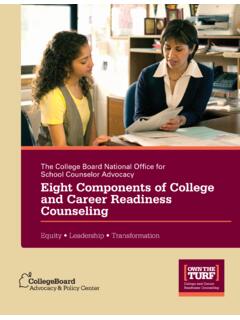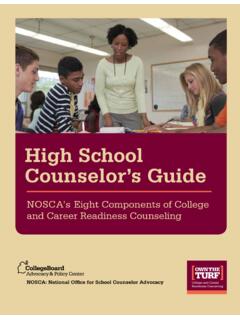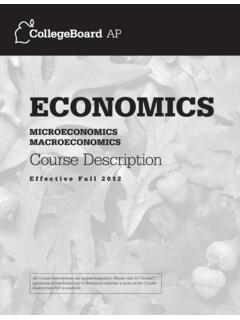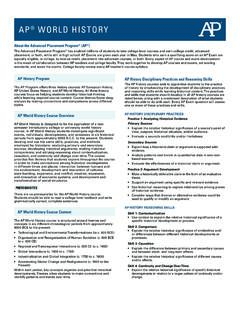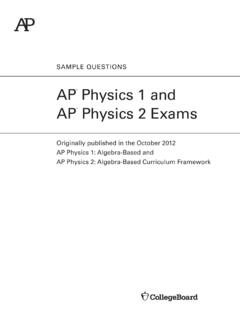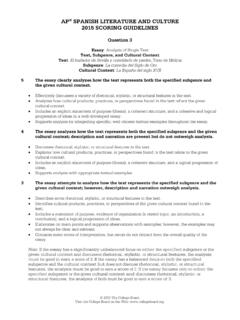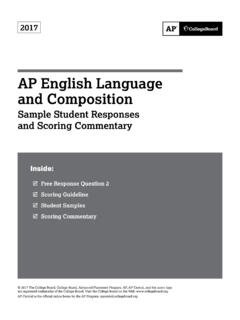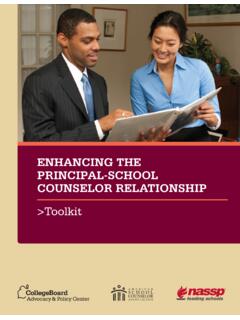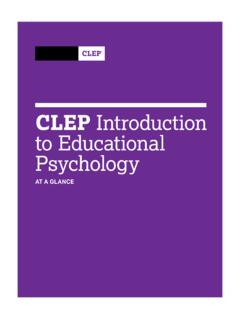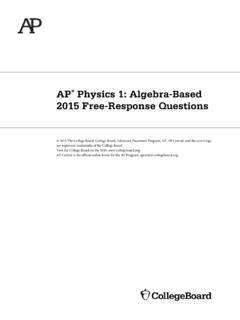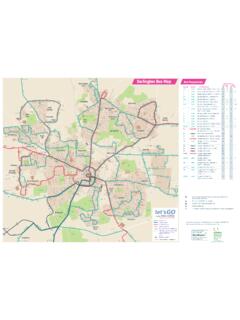Transcription of AP US History 2012 q4 - College Board
1 AP UNITED STATES History . 2012 SCORING GUIDELINES. Question 4. Analyze the origins and outcomes of the intense cultural conflicts of the 1920s . In your response, focus on TWO of the following. Immigration Prohibition Religion The 8 9 Essay Contains a clear, well-developed thesis that addresses the origins and outcomes of the intense cultural conflicts of the 1920s regarding two issues. Develops the thesis with substantial and specific relevant historical information related to two issues. Provides effective analysis of the origins and outcomes of the intense cultural conflicts related to two issues; treatment of the two issues may be somewhat uneven; treatment of origins and outcomes for each issue may be somewhat uneven. May contain minor errors that do not detract from the overall quality of the essay. Is well organized and well written. The 5 7 Essay Contains a partially developed thesis that addresses the origins and outcomes of intense cultural conflicts of the 1920s regarding two issues.
2 Supports the thesis with some relevant historical information related to two issues. Provides some analysis of the origins and outcomes of the intense cultural conflicts related to two issues; treatment of the two issues may be substantially uneven; treatment of origins and outcomes for each issue may be substantially uneven. May contain errors that do not detract from the overall quality of the essay. Has acceptable organization and writing. The 2 4 Essay Contains an undeveloped, confused, or unfocused thesis or simply paraphrases the question. Provides minimal relevant information or lists facts with little or no application to the question. Describes two issues in a general way or addresses outcomes and origins of only one issue. May contain major errors. May be poorly organized, poorly written, or both. The 0 1 Essay Lacks a thesis or restates the question. Demonstrates an incompetent or inappropriate response or is off topic (zero).
3 Contains numerous errors. Is poorly organized, poorly written, or both. The Essay Is blank. 2012 The College Board . Visit the College Board on the Web: AP UNITED STATES History . 2012 SCORING GUIDELINES. Question 4 (continued). Potential Outside Information Immigration Origins Increased immigration from southern and eastern Europe ( new immigrants ) between 1891 and 1920 (25 million between 1865 and 1915, more than four times the number in the previous 50 years;. million arrived after the First World War); increased immigration from Mexico, 1921 1930. Immigrants arrived with little money and little education; lived in tenements (crowded, unsanitary, with inadequate public services); clustered in ethnic communities ( immigrant ghettoes ); created organizations around ethnic/religious identities (Irish: Roman Catholic parish; Jews: synagogues, Hebrew schools; Germans: singing societies) that were seen as a barrier to assimilation.
4 Labor unions feared immigrants would act as strikebreakers; immigrants were seen as difficult/undesirable to unionize. Nativism prior to 1920 and in 1920 seen in the following: o Some Progressives favored immigration restriction as a way to solve urban problems (poverty, overcrowding, social unrest, unemployment, drug use); also wanted to assimilate immigrants through Americanization. o American Protective Association (anti-Catholic) advocated immigration restriction (1890s). o Immigration Restriction League 1894. o 1917 Immigration Act did the following: Required literacy test (earlier attempts to pass literacy tests vetoed by Grover Cleveland in 1896, by William Howard Taft in 1913, by Woodrow Wilson in 1915; in 1917 Wilson vetoed another; this act was passed over his veto); prohibited certain political radicals. Created Asiatic Barred Zone (Japan and Korea were left out, but prior limitations on laborers from China and Japan still applied).
5 Mexicans were exempted temporarily. o Antiforeign sentiment during First World War, particularly against German Americans;. focus on 100% Americanism.. o Post First World War depression blamed unemployment on increased immigration; AFL. proposed halting immigration for two years; fear that immigrant workers raised unemployment and lowered wages. o Red Scare 1919 1920: fear of radicalism and association of immigrants with radicalism; fear of Bolshevik Revolution; 1920 bombing on Wall Street killed 38 and was blamed on immigrant anarchists. o Anti-Chinese and anti-Japanese attitudes arose in the United States, particularly in the West, during late 19th early 20th centuries. o Fear of southern and eastern Europeans grew. o Race-thinking and eugenics became popular (Madison Grant, The Passing of the Great Race, 1916). o Some western states forbade Asian immigrants to own or lease land: California's 1913 Alien Land Act stated aliens not eligible for citizenship could not purchase or lease land for longer than three years.
6 Ku Klux Klan became more powerful in the 1920s : o Revived in 1915: William J. Simmons, The Birth of a Nation, Edward Clarke, Elizabeth Tyler. o Hiram Wesley Evans became imperial wizard in 1922. o Advocated 100 percent Americanism.. o Championed white supremacy (slogan: Native, White, Protestant Supremacy ). 2012 The College Board . Visit the College Board on the Web: AP UNITED STATES History . 2012 SCORING GUIDELINES. Question 4 (continued). o Became a force in Democratic Party politics, particularly in Midwest and small-town United States. o Practiced systematic terror against blacks, Jews, Catholics, foreigners. o Faded after D. C. Stephenson affair, Indiana, 1925. o Lothrop Stoddard, in The Rising Tide of Color Against White World Supremacy, 1924, warned against weakening of white race through immigration and mongrelization ;. believed in race types.. Anti-Catholicism and anti-Semitism were popular. Many small-town and rural Americans feared urbanization.
7 Outcomes Ku Klux Klan expanded in the 1920s . Challenges arose to race-thinking and nativism: cultural pluralism (Horace Kallen's term in 1924);. anthropologists argued that no scientific evidence existed for racial theories or hierarchical order of societies from primitive to civilized (Franz Boas, Ruth Benedict). Some immigrants championed the idea of ethnic Americans; B'nai B'rith and National Catholic Welfare Council lobbied against discrimination against immigrants by employers, colleges, or government. Trial of Nicola Sacco and Bartolomeo Vanzetti, 1921, and execution, 1927, showed fear and association of immigrants with political radicalism. California's 1920 Alien Land Act prohibited land rentals by aliens ineligible for citizenship or by corporations with stock held by aliens ineligible for citizenship. Immigration Act (Emergency Quota Act) of 1921 included the following: o Established overall maximum of 357,000 immigrants per year.
8 O Established quotas based on national origins: 3 percent of each country's nationals residing in United States in 1910. Married Women's Act (Cable Act) of 1922 said that any woman citizen who married an alien ineligible for citizenship shall cease to be a citizen of the United States ; women could not acquire citizenship by virtue of spouse's status but instead had to apply on their own. Ozawa v. United States (1922) decided that Japanese immigrants were inassimilable aliens and racially ineligible for United States citizenship; Supreme Court ruled that the definition of race was not a scientific one but was based on the understanding of the common man ; therefore white persons, the phrase in the law, meant northern and western Europeans. In Myer v. Nebraska (1923), the Supreme Court struck down state laws prohibiting teaching in a language other than English. In United States v. Thind (1923), the Supreme Court ruled that Asian Indian immigrants were inassimilable aliens and racially ineligible for United States citizenship.
9 Johnson-Reed Immigration Act (National Origins Act) of 1924 established National Origins Plan to begin 1929: o Cut maximum to 164,000 and reduced European quotas to 2 percent of nationality in United States in 1890, thereby discriminating against southern and eastern Europeans. o Excluded aliens ineligible for citizenship (East and South Asia, Japan; Chinese already excluded by law 1882, 1892). o Filipinos, Mexicans, Canadians (Western Hemisphere) exempted. o Prevented Asian women from joining their husbands in United States. o Allowed foreign-born wives and children of United States citizens to enter as nonquota immigrants. o Divided balance of world into so-called five colored races (black, mulatto, Chinese, Japanese, Indian). 2012 The College Board . Visit the College Board on the Web: AP UNITED STATES History . 2012 SCORING GUIDELINES. Question 4 (continued). o Created a new category: illegal alien.. In Hidemitsu v. United States (1925), Supreme Court forbade naturalization of Japanese (to maintain distinction of race and color in naturalization laws).
10 Hispanic immigration included the following: o Legal arrivals from Mexico peaked at 89,000 in 1924, after which the Mexican government restricted emigration to United States. o Illegal immigration increased because of southwestern agricultural productions and the demand for stoop labor.. o Hispanics were the fastest growing minority in the United States, especially from Mexico, Puerto Rico, and Cuba. o Mexican communities grew in San Antonio, Denver, El Paso, and Los Angeles; smaller communities existed in Chicago, Detroit, Kansas City, and Gary; Spanish Harlem in New York City; barrios. o Formation of mutual aid societies (mutalistas), which became centers of resistance to civil rights violations and discrimination. o Federation of Mexican Workers Unions was formed in 1928. o League of United Latin American Citizens was formed in 1929 by middle-class Mexican professionals. United States Border Patrol was established in 1925; made border crossing from Mexico more difficult (head taxes, visa fees, literacy tests, document checks).
